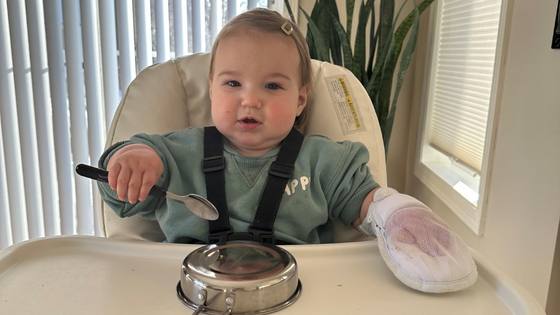What is possible when a therapy long known to be safe and effective for older kids is used at an earlier stage in a child’s development?
Through a recently launched pilot study, Mark Gormley, MD, a physical medicine and rehabilitation physician, and Kelli Moberg, OT, hope to show that infants with hemiplegic cerebral palsy (CP) who complete Infant Constraint Induced Movement Therapy (CIMT) make meaningful, positive changes in their functional abilities—even years later.
“At Gillette Children’s, we’ve wanted to focus on getting infants and toddlers into treatment as early as possible to take advantage of the amazing neuroplasticity of infant brains,” says Dr. Gormley. “The earlier a child can get diagnosed and begin treatment, the better their outcomes.”

CIMT study participant Lydia wears a mitten during exercises designed to encourage use of both hands.
What is Infant Constraint Induced Movement Therapy (CIMT)?
CIMT is a rehabilitation therapy used to treat children with neuromotor conditions, like hemiplegic cerebral palsy, that affect one side of their body. In CIMT, the patient wears a restraint (for infants, a mitten) on their stronger hand while their weaker hand is guided through various activities and exercises. The technique encourages patients to use their weaker hand, which in turn helps them strengthen it and use it more skillfully and in two-handed activities.
Early Signs of Promise
It’s well-published that CIMT is an effective treatment for children ages 24 months and older. Most studies show that the weaker hand becomes a better helper when combined with two-handed training. This dramatically impacts day-to-day activities requiring two hands, such as dressing, grooming, and participating in play and school.
Though this study follows a small number of infant patients, early observations show great promise. Moberg, a national expert in Infant CIMT, says, “The infants’ gains have been more robust than the older kids we have seen who have started treatment closer to years or older. Our results show we're having a bigger impact by initiating treatment by or before 12 months of age than if we did around 2 years or older.”
The pilot study will follow participants until they are four years old. Dr. Gormley and Moberg hope to expand the study to investigate further the benefits of CIMT for infants diagnosed with or at risk of CP.
See how CIMT helped one study participant, DJ, use both hands with greater ease.
Get Gillette Stories in your inbox!
Stay “in the know” with our Gillette Stories! Receive the latest stories and news from Gillette delivered straight to your inbox..
 Home Page
Home Page


